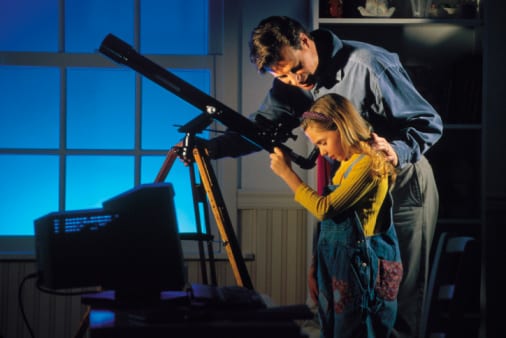Earth science provides opportunities for hands-on activities for kids to explore and learn. Earth science encompasses many subcategories related to the earth. Geology, meteorology, oceanography and astronomy fall under the earth science category. Reading about the concepts that fall under these categories is educational, but seeing the concepts in action is a more effective way to teach kids.
Volcano Model
The erupting model of a volcano is a classic earth science activity appropriate for kids of all ages. A model volcano is constructed from basic supplies found in most homes. Start by cutting the neck off of a soda bottle. Glue it to a piece of cardboard. Use modeling clay or paper mache to mold a volcano shape around the plastic bottle. Allow the material to dry fully. Paint the volcano to make it look more realistic. After the volcano is dry, place 1/2 cup of vinegar, a few drops of liquid dishwashing soap and red food coloring in the bottle. Place about 4 tablespoons of baking soda in a square of tissue. Drop the tissue in the top of the volcano opening and wait for it to erupt. This activity can be very messy. Place the volcano on the cardboard in a baking pan or do this project outside.
Outer Space Pen Pals
This earth science activity requires kids to write a letter to an outer space creature. Because the outer space creature has never visited Earth, the letter should provide a detailed description about the planet. Start by brainstorming facts about the earth that are important. Kids are then encouraged to write these facts into a letter format addressed to their space creature pen pals. Children will have the chance to further explore facts about the earth while practicing their writing skills.
Rock Collection
A nature walk provides the opportunity for kids to collect rocks. Encourage children to collect as many different rocks as they can find. Visit different locations such as forests, beaches, parks and residential areas to find a greater variety of rocks. Use books borrowed from the library or websites to help identify the types of rocks collected. Clean the rocks so they can be analyzed. Make observations about the rocks and record the observations in a journal. Rocks can be sorted by type and characteristics. Keep the collection, adding to it when new rocks are discovered.
Erosion
A visual demonstration of erosion will help kids understand the process. Tongue depressors will help demonstrate the amount of erosion caused by water. Measure and mark lines 1 centimeter apart from top to bottom of several tongue depressors. Color in each section of the tongue depressors with a different color of crayon. Use the same order of colors on every tongue depressor for accurate comparison. Once outside, let the kids create a big pile of dirt to form a mountain. Place the tongue depressors at random locations on the mountain and around the base. The tongue depressors should all be placed in the dirt so the top halves are showing above the ground. Give the kids a watering can and encourage them to pour it over the mountain of dirt. Ask them to make observations about the changes in the mountain. The tongue depressors can help them identify the changes based on how much of them are showing.
Weather
Kids can study the weather in many ways. Begin by discussing different types of weather and how they are created. Create a weather chart to record the daily weather. Create a grid to coordinate with either a weekly or monthly calendar. Create picture cards to represent weather possibilities. Each day, ask your child to identify the type of weather. Choose the corresponding picture card and affix it to the weather chart for that day. Watch the weather segment of the news with the kids. The following day, compare the predictions made by the meteorologist to the actual weather.





